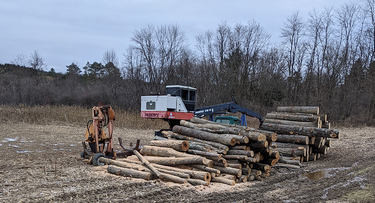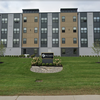Town lets logger remove already-cut trees
The Enterprise — Melissa Hale-Spencer
This pile of timber is worth about $5,000. René Savoie had been unable to move it since, on Dec. 29, he had been asked to stop logging land on the outskirts of Altamont. Last week, the town planner said Savoie could move it but Savoie said he has to wait for the right weather.
GUILDERLAND — Last week, the town planner met with René Savoie at his logging site on the outskirts of Altamont and told him he could move the piles of timber he had already cut.
“The Town will have no issues with you cutting and splitting the logs that have been felled and stacked in the log process area,” Kenneth Kovalchik wrote in an email to Savoie on Jan. 18.
As The Enterprise reported in a story published on Jan. 17, Savoie has three separate, neatly stacked piles of timber, which together are worth about $10,000.
Kovalchik also said that Savoie could remove the 10 to 15 trees he had already felled since he stopped working on Dec. 29 at the request of the state’s Department of Environmental Conservation. The DEC says Savoie has not been in violation.
Savoie told The Enterprise he is losing over $10,000 a month as his equipment is unused at the site.
Kovalchik’s email also said, “Please be aware that no additional trees can be cut down at this time.”
On Jan. 19, the town posted a notice on its website about the latest with logging the property between Gun Club Road and Armstrong Drive, saying that, on Nov. 9, Guilderland received an application for a 41-lot single-family subdivision there and later became aware of tree-cutting operations on the property and issued three cease-and-desist orders to prevent any further tree-cutting.
Armstrong Drive residents had been distressed to hear trees being felled, presumably to make way for the housing development. Kovalchik and the town’s chief zoning and building administrator had issued two cease-and-desist orders — one in November and another in December — to the developer, Jason Zappia, and his engineer.
Savoie and his brother had started logging on Nov. 1, in the window prescribed by the DEC — from Nov. 1 to March 31 — to protect the northern long-eared bat, which hibernates in caves in the winter but returns to live in trees in the spring.
A third order — this time including Savoie and the property owner, Richard Friedlander — was issued in early January. No trees have been felled since.
Savoie told The Enterprise on Jan. 20, “They gave us permission [to remove the cut timber] but it all depends on the weather. Right now, the ground is too soft. The ground has to be frozen to get trucks in.”
“According to Mr. Savoie, he was not made aware that a subdivision application had been filed by Mr. Zappia and that Mr. Zappia had an option to purchase the property from the Friedlanders,” Kovalchik wrote in an email, answering a series of Enterprise questions.
“Unfortunately he got caught in the middle of a bad situation,” said Kovalchik. “As for the operation, the logging roads were in good condition and the log processing areas were organized and well kept.”
Asked when Savoie would be able to finish logging the 40 acres of land for which Friedlander had hired him, Kovalchik said, “No further tree cutting is allowed while there is an active major subdivision application that has been submitted to the town.”
Further cutting of trees cannot continue, he said, until the subdivision application has been approved or the application has been formally withdrawn.
The Guilderland Town Board, at its Jan. 3 meeting, listened to extensive resident complaints and issued a directive to the planning board to suspend further review of the subdivision proposal. It also authorized the town attorney, James Melita, “to bring any request for injunctive relief in the event there are any further violations.”
Kovalchik told The Enterprise that the three subdivision regulations listed in the cease-and-desist order may have been violated by the tree-cutting.
Those potential violations include: removing features, such as trees, that would add value to a residential development; removing more trees than necessary to make construction feasible while all other vegetation is to be left in place; and stripping more than 25 percent of its cover from an approved plat.
“This is an issue the Planning Board could take under consideration if the subdivision application proceeds,” Kovalchik told The Enterprise.
Savoie, who has been in business for more than 40 years, told The Enterprise that it is common practice for a landowner, like Friednlander, to log his land before selling to get the value of the timber.
The Enterprise asked Kovalchik, if Jason Zappia had not proposed a subdivision for that land, would there have been any violation in logging the land?
“As long as the logging company was complying with any relevant DEC regulations, there would have been no violations,” said Kovalchik.
The Enterprise also asked, if the town’s newly adopted forestry law had been fully implemented, would Savoie’s activities have been in violation of that?
“Not necessarily,” responded Kovalchik. “If the land disturbance was under 1 acre it would require no review by the Tree Preservation Committee. The proposed logging activities may have had to be reviewed by the Tree Preservation Committee that will be formed.”


